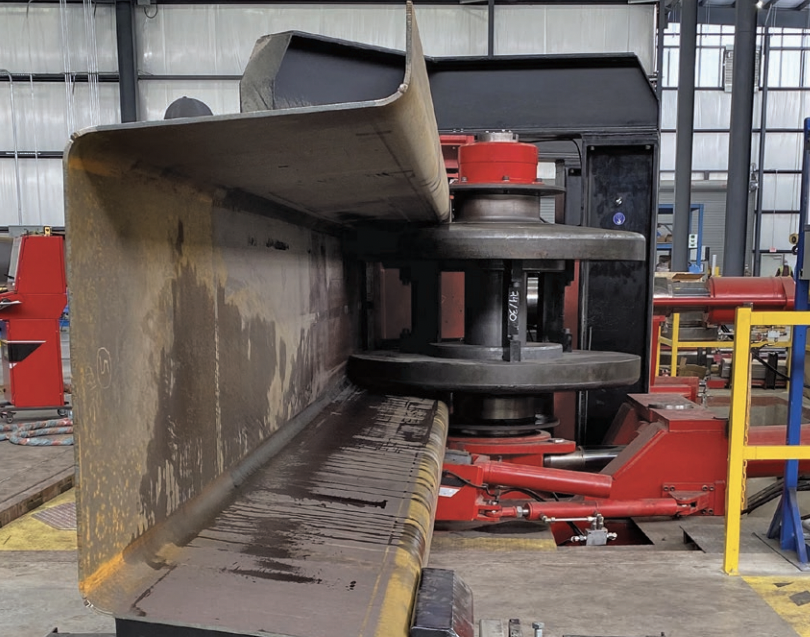“We saw a lot of promise in press-brakeformed tub girder technology for short-span bridge applications so we made the decision to enter that space,” says Guy Nelson, Valmont’s business development director, North American structures.
Above: Valmont’s bridge beam gives bridge owners an economical, sustainable solution with its quick installation and minimal maintenance requirements.
Septmber 2022 - In 1966, the classic TV series “Star Trek” introduced viewers to the crew of the starship USS Enterprise, including the ship’s chief engineer, Montgomery Scott. Amid the challenges of a fi ve-year mission in space, Scott y’s knack for solving impossible problems earned him the nickname “the miracle worker.” Leaders at Valmont Industries Inc. also felt the lure of uncharted territory when they undertook a mission to enter the bridge building market in 2019. Founded in 1946, the Valley, Nebraska-based company designs and manufactures engineered products, utility support structures and mechanized irrigation equipment for the infrastructure, renewable energy and agriculture industries. “We saw a lot of promise in press-brakeformed tub girder technology for short-span bridge applications so we made the decision to enter that space,” says Guy Nelson, Valmont’s business development director, North American structures. The venture meant developing and testing a new product, building a dedicated production facility in Jasper, Tennessee, and sourcing the heaviest, strongest rolling machine in the industry. Th e need to manage and complete these projects almost simultaneously meant Valmont’s team had to perform some miracle work of their own.
STRUCTURAL STEEL 
The company drew on its existing knowledge of state DOT regulations and its experience manufacturing mast arm traffi c poles, street lighting, wireless communication structures forming and fabrication processes. “We knew we needed to camber the tub girder to off set dead load defl ections or roadway profi le requirements,” Nelson says. “Typically, in structural steel applications, camber is introduced by heat. But the process takes a skilled worker and the results can be unpredictable.” Valmont chose to camber its press brake tub girder with a three-roll rolling machine from Davi Inc. In 2020, Valmont initiated a footprint design for its Jasper production facility and introduced its press-brake-formed tub girder to the marketplace. In 2021, Valmont broke ground on the factory while the project team researched rolling equipment capable of cambering the girder. Nelson says the company relied on the technical expertise of Davi’s design team. “Th ey listened to our needs and custom-engineered an MCP XXL rolling machine to help us get the job done.” Headquartered in Emilia-Romagna, Italy, Davi manufactures plate and angle rolls, and operates its U.S. branch in Dallas. Th e company has produced patented technology and industry fi rsts that include its MCP XXL rolling machine, built to meet requirements for parts with large and extra-large dimensions and very strict tolerances. The MCP’s high-resistant, large-diameter, hardened structure allows steel shafts to rotate on pre-greased, self-aligning roller bearings, ensuring excellent performance and effi ciency with virtually no defl ection. Th ree independent hydraulic motors and three high-torque planetary drives (one for each roll) are coupled directly to the rolls through a splined shaft , for a powerful torque transmission to ensure an easy feeding of girder sections during cambering. To avoid defl ection of the shaft s, the planetary guide system is powered by hydraulic cylinders mounted outside the main machine frame, as close to the bending or cambering area as possible. Guide rolls, adjustable in three directions, are activated by hydraulic cylinders controlled from the console panel. A set of customized guides, designed and integrated into the machine, prevents deformation to the girders. “We wanted a machine that could support our goal to standardize beam shapes and components,” says Carl Macchietto, vice-president of product and management for Valmont. “We wanted to be able to produce girders in fi ve diff erent sizes, all using 3/8-in.-thick plate or coil.” Th e 60-in.-wide MCP was commissioned in 2021 with pilot runs on the bridge beam taking place in Jasper. The Valmont bridge beam is available in sizes ranging from 12 in. deep, 94 lbs. per linear foot to 33 in. deep, 161 lbs. per linear foot. The tub girder consists of a steel plate formed by cold bending with a press brake. The U-shaped plate is then cambered anywhere from 2 in. to 8 in. on the MCP to offset any dead load deflections or roadway pro - file requirements. Davi’s iRoll-Camera allows Valmont to map out the girder’s curva - ture. The camera is located above the operation to provide a bird’s-eye view of the entire part. When a blueprint, .DXF file or CAD file is imported to the CNC, it appears as an overlay.
SUSTAINABLE SOLUTION
“Using the MCP and camera, we camber the girder to match the calculated profile of the bridge beam,” says Macchietto. “We then remove the girder and recheck the camber of the bridge beam placed in a position as though it was installed at the final site location. If the girder curvature meets specified tolerances, we send the bridge beam to the next stage of the manufacturing process, including adding the bracing angles across the top flanges at specific spacings, welding the steel plate diagrams places at the bearing locations, and a sin - gle row of shear studs on the top two flanges by a semi-automated stud welder. These shear studs are spaced for a project’s fatigue and strength requirements.” Valmont’s bridge beam eliminates the most costly component of a welded steel I-beam—the web-to-flange weld—and removes a tension zone fatigue sensitive detail, according to Nelson. “It can be inspected with simple visual observation of the coating to make sure there is no section loss. If galvanized with a zinc coating, the bridge beam has a 70-year maintenance-free coating life cycle and an overall service life of 100 years.” Both the steel and zinc are recyclable, he notes, which helps to cre - ate a more sustainable infrastructure. The tub girder can be installed in hours by a construction crew, requires minimal maintenance and is long-lasting. This provides an economical and sustainable solution for bridge owners. With shorter project times, traffic disruption is also reduced, Nelson says. “Valmont is about improving life through innovation, sustainability and efficiency,” Macchietto says. “We currently build smart technology into our street poles. We are looking at incorporating smart technology into our girders as well to improve safety and inspection.” “New steel is being developed that doesn’t require a coating,” says Nelson. “We are already looking at advanced materials that would sub - stantially increase the life cycle of our tub girder by up to 200 years.” Valmont’s Jasper facility holds an American Institute of Steel Construction (AISC) certification for structural steel fabrication and construction. “We’re relatively new to the bridge market to earn that certification,” says Nelson. “Gaining AISC approval and fabri - cating a new type of bridge girder in just a couple years is relatively unheard of.” The MCP rolling machine is also an outlier piece of equipment because no one has processed this kind of shape on one before. FFJ












